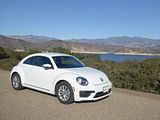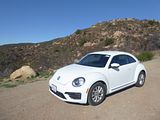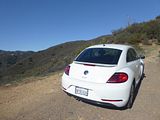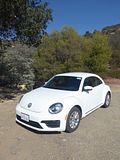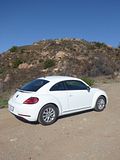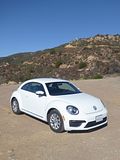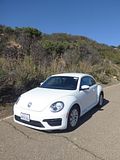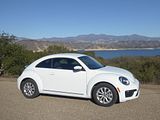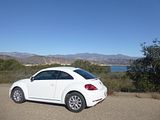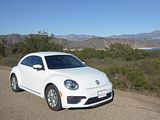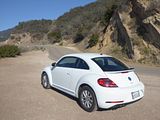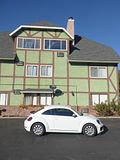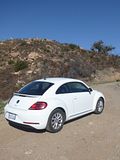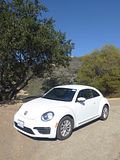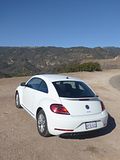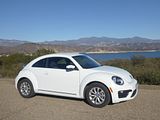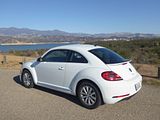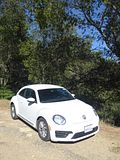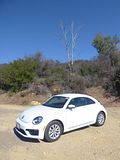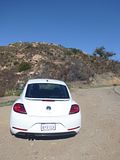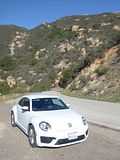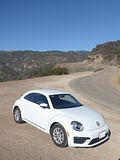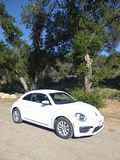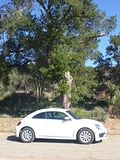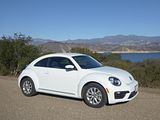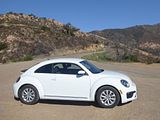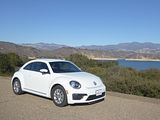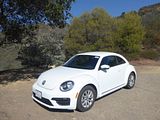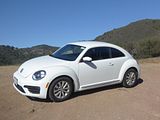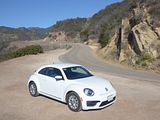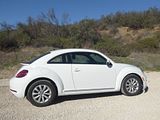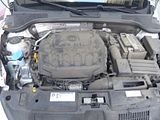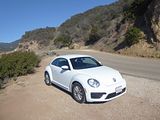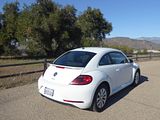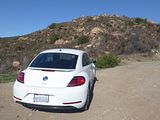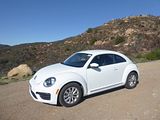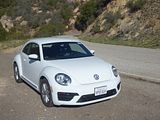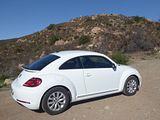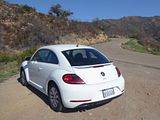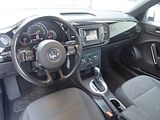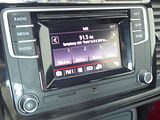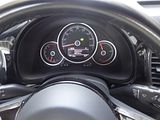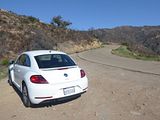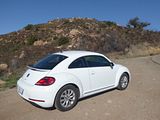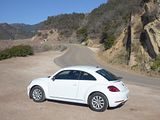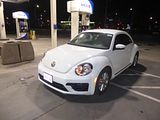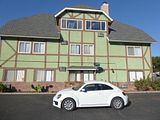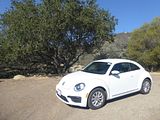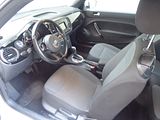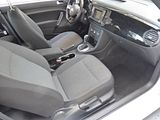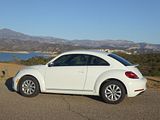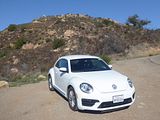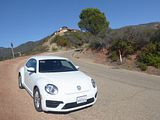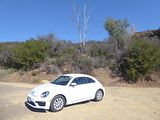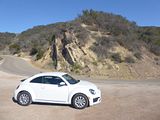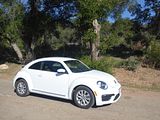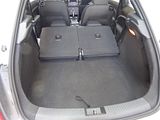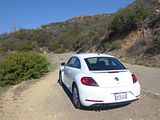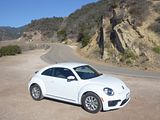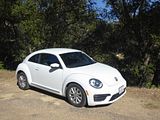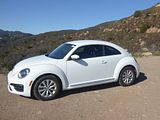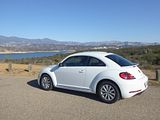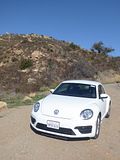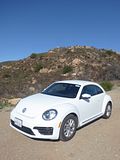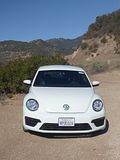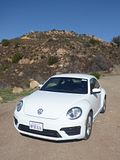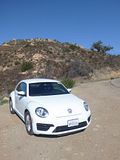Despite the fact that we live in an era crammed with ever more technology in just about every aspect of our lives, there is no doubt that retro also sells. Many car manufacturers have tested this out in the last twenty years or so and generally found that the combination of modern build quality standards and engineering with styling redolent of a past era is very popular. The success of the modern MINI and Fiat’s 500 certainly evidences that and higher up the market, the reborn muscle car trio of Dodge Challenger, Chevrolet Camaro and Ford Mustang further proved the point. VW enjoyed success with this approach, too, with such a positive reaction of the Concept One car that they showed at the 2004 North American International Auto Show that they embarked upon a series program to put what they called New Beetle into production in late 1997, with the first deliveries starting in early 1998. For a while, especially in fashion-sensitive places such as Southern California, it was “the” car to have and there were quite long waiting lists, but fashion can be quite a fickle thing, and whilst the modern MINI has proved enduringly popular and Fiat have been able to sell every 500 they could build ever since the 2007 launch, Beetle sales reduced quite quickly. Whilst the styling made the New Beetle like quite different to all the other cars in the VW range, the business case to build it only worked because underneath it used a platform, engines and components that were being made in vast quantity for other cars, so as this evolved, so VW had to make the decision whether to update the Beetle to continue to enjoy those economies of scale or whether to make it a one-series wonder. As the original Beetle barely changed in appearance over its very long life, it was not as easy to do as Ford chose to with their Mustang, using design cues from the 1960s car’s evolution for the evolution of the modern Mustang. VW decided they would go ahead and the plan for a new model was pre-announced in the autumn of 2010, when Oprah Winfrey declared that everyone in the audience of the final “Oprah’s Favourite Things” show that evening would get one on release. There was then a teaser commercial during the SuperBowl XLV the following February, before the production car made its debut at the Shanghai and New York Auto Shows in April 2011. Based on the PQ35 platform of the then current Jetta, and built alongside that car in Mexico, what is sometimes referred to as the A5-generation Beetle was longer, wider and lower and had styling that was intended to distance it from New Beetle, even though the overall result could never really be mistaken for anything else. Whilst it has got its fans, it has never quite captured what that 1998 car did, and sales have been steady but unspectacular even in America, the car’s prime market. I sampled one in 2016, not long after the first examples hit the US rental fleet and found much to like, though did note that this was not really practical family transport, as there was not quite enough space for a whole family to sit in it. Those cars reached the end of their time in the rental fleets and were not replaced, probably because of low demand from rental customers, but I noticed around the end of 2018, that a new batch arrived, along with some other Volkswagens. These were mostly 2019 model years cars and would be among the last to be built, as VW had announced that production would cease during the model year. Seemingly, a few of them lingered in the fleet, as on a November 2021 day at LAX when there was nothing much to inspire me for the day’s rental I spotted a freshly washed white car being parked up. I decided to take it to see what I thought of the car in its twilight years.
The A5-generation Beetle has changed remarkably little during its production life, with the car looking the same now as it did back in 2011. There have been changes, of course, most notably under the bonnet, with a variety of engines on offer, updated in line with changes VW made across the rest of their range. Even in the US market where there have been fewer options than there were in Europe, the car has gone from the characterful 2.5 litre five cylinder unit to a 1.8 litre four cylinder TSI in 2015 and then that was swapped out for a larger but no more powerful 2.0 litre unit for the final years of production. More powerful cars, the diesels and manual gearboxes all disappeared a couple of years ago. There have been countless limited editions, of course and equipment levels have been upgraded, technology and safety features added and the trim names altered, but in essence the Beetle of 2019 is pretty similar not just to the car I tested in 2016 but even a launch edition car from 2012.
During the lifetime of this generation of the Beetle there have been various engine options, even in the US market. For the final year of production VW America standardised on just one engine, a four cylinder 2.0 TSi unit which generates 174 bhp, coupled to a six speed automatic gearbox. There is a slightly throaty roar to the engine at times, which I found rather agreeable, and the Beetle goes quite well, with strong acceleration whether you are moving away from a red light or want a burst of power to get past a slower vehicle on the freeway. Peak torque is developed low down the rev range, from 1500 rpm The gearbox is well matched to the engine and made very smooth changes that were often hard to detect, with the car shifting down when needed on steeper inclines. At cruising speed the Beetle is smooth and quiet with all potential noise sources well suppressed. I covered 278 miles in my time with this Beetle and it needed 8.4 US gallons to refill it, which computes to 33.09 mpg US or 39.54 mpg Imperial, a good result, helped no doubt by quite a long haul at a steady speed on the freeway. I note that this is slightly worse than the 2016 test car, but the couple of mpg penalty could easily be attributed to a different mix of roads and possibly even how full the tank was on collection.
Despite being based on the chassis and many of the components that make the Golf a good car to drive even in its less costly versions, the Beetle has never scored as highly, but actually I found this one, just like that 2016 test car, was really not bad at all. The steering has some feel to it without being overly heavy, the car corners tidily with little in the way of body roll and plenty of grip. It also rides well, coping with the often challenging road surfaces of Southern California, absorbing bumps well. The brakes work with no drama, and only light pedal pressure being needed and there is a conventional pull-up handbrake between the seats. The only real challenge while on the move is visibility. The mirrors are small, and whilst the view forwards and sideways is not too bad, the thick C pillars, large rear headrests, small rear window and sloping rear mean that oblique junctions require care and you really do need the rear-view camera wen parking up. There is a Blind Spot Warning system, which is useful, as ever.
The second generation of New Beetle dialled back the retro theme on the dashboard a little. Although a lot of the individual components are shared with other models in the VW range, the Beetle does have a style of its own. The overall quality looks decent enough despite the fact that there are a lot of rather hard plastics being used. The large black plastic inlay panel in front of the passenger probably does not help lift the ambience very much. At least there is a leather wrapped steering wheel even in the entry level models. There are three overlapping circular instruments in a single cluster, with a central speedometer, and much smaller rev counter to the left and fuel gauge to the right. There is a small trip display area in the lower portion of the speedometer and you can cycle through the display using buttons on the right hand steering wheel spoke. The left hand spoke buttons are used for audio repeater functions. The cruise control operates from a column stalk on the left and there are the usual two other stalks for indicators and wipers. Lights are a turn wheel mounted high on the dash to the left of the wheel. This entry level version of the Beetle has one of the most basic touchscreen and radio systems you will find these days. That is not entirely a bad thing as it is extremely easy to operate. The screen is just 5” and all you get is AM/FM radio capability, with eight speakers, a USB port and Bluetooth. Sound quality was good. There are three rotary dials for the air conditioning control, meaning that this is also very easy to use. The system proved quite effective on what was quite a warm day.
The front seats are spacious and accommodating and proved comfortable. There is a full range of adjustment, all of it manual. Somewhat to the chagrin of many Americans, there is a turn wheel on the side of the seat to alter backrest rake, which means that you can set it to the exact angle you want, though the wheel is a bit awkward to reach. The steering wheel telescopes in and out, so it was easy to get the driving position I wanted. There is a nice feeling of space here.
Things are not quite so good for those in the back. For a start, it is quite hard to get in, and once installed, adults will find that space is quite restricted. This really is a four seater as opposed to five, and the sloping roofline does mean that headroom is a bit limited. There is just about enough legroom even if the front seats are set well back. There are armrests moulded into the side panels and occupants here get a single cup holder in the rear part of the centre console where you will also find a 12v charging point.
Whilst the boot of the hatch/coupe version of the Beetle is a lot more spacious than that of the Convertible model, and also those of either the Fiat 500 or MINI, it is still not particularly commodious. The floor area is not really the problem, but the sloping rear end of the car’s styling means that capacity is quite limited as there is not that much of the floor area with the full height available. There is a space saver under the boot floor but it is packed in tightly with no extra room around it for odds and ends. You can, of course, create more space by dropping the rear seat backrests down. They are split 50/50 and the resulting load area is more or less flat. Inside the cabin, things are rather better, with a decently sized glovebox, door pockets, a cubby over the driver’s left knee, an armrest cubby and a recess in front of the gearlever.
For the US market, the 2019 Volkswagen Beetle is available in two body types: coupe and convertible. Both come in four trim levels: S, Final Edition SE, SE, and Final Edition SEL. All models boast a 174 bhp four-cylinder engine and six-speed automatic transmission. Standard features in the entry-level Beetle S include the MIB II infotainment system, a 5-inch touch screen, an eight-speaker stereo, Bluetooth, a USB port, cloth upholstery, a leather-wrapped steering wheel, blind spot monitoring, rear cross traffic alert, a rearview camera, and alloy wheels. The convertible body style also has heated front seats, synthetic leather upholstery, and a power-folding soft top. The SE adds 17-inch wheels, a sunroof, automatic headlights, automatic wipers, keyless ignition and entry, an auto-dimming rearview mirror, simulated leather upholstery, dual-zone automatic climate control, heated front seats, a 6.3-inch touchscreen, HD and satellite radios, VW Car-Net App-Connect (adds various smartphone-integration apps, most notably Android Auto and Apple CarPlay) and VW Car-Net Security & Service emergency communications. The optional SE Premium package adds 18-inch wheels, bi-xenon headlights and LED taillights, front and rear parking sensors, a Fender audio system, and a 6.3-inch touchscreen with navigation. On top of the standard SE equipment, the Final Edition SE gets unique 17-inch wheels, special cloth upholstery with simulated leather inserts, some additional Beetle badges on the exterior and interior, and stainless steel pedals. The top-trim Final Edition SEL comes with just about every feature you can get in this Volkswagen, including the SE’s optional equipment, plus 18-inch wheels, heated front sport seats and genuine leather upholstery.
I quite enjoyed this Beetle, just as I rather liked the one I sampled back in 2016. The car has its own distinctive style and a bit of personality and yet by being based on proven VW components, it is better to drive than you might think, with that roar from the engine being a highlight and the good ride being something you don’t get in enough cars these days. So a pleasant car with no real vices and pleasing fuel economy and yet it remains affordable to buy and run and it is blessed with engineering that is proven in volume models like the Golf and Jetta. It’s a shame that cars like this are being dropped from production, but a glance at the sales figures shows that is hard to make a case to carry on building it or even to fund a replacement. Whilst in 2012, a total of 28,654 examples of the hatch model were sold in the US, by 2018 that figure was down to just 8.636, and the convertible only added 5,775 to that. I was glad to be able to renew my acquaintance with the Beetle and just think that as the automotive landscape moves ever more to rather uniform-looking SUVs of every size, it’s a pity that it will be ever harder to have something that stands out like the Beetle of any age does.


